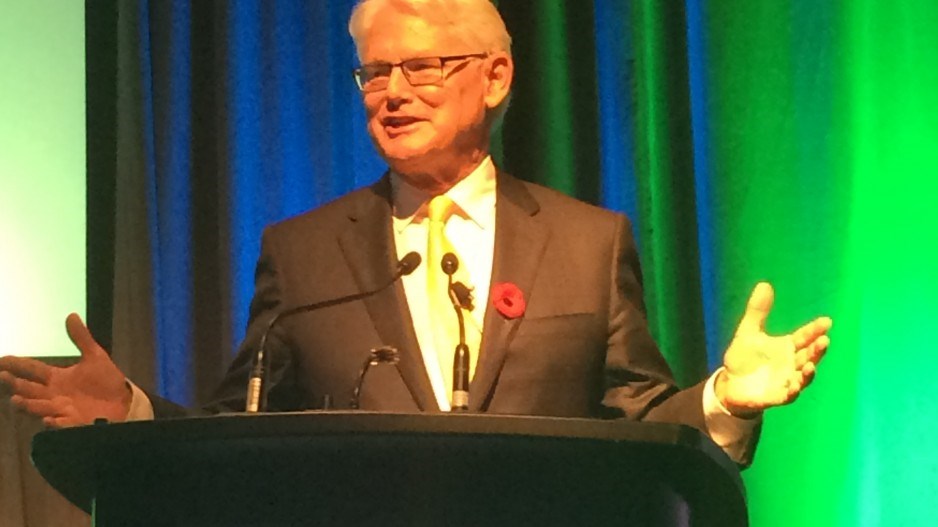Two former Vancouver mayors and B.C. premiers – Mike Harcourt and Gordon Campbell – offered some very different perspectives on the Site C hydroelectric dam project at last week’s Generate clean-energy conference.
Campbell also offered what sounded like a mea culpa that his original plan for carbon tax increases stopped at the five-year mark, and offered hope to an independent power sector that fears it could wither in the shadow of Site C.
On Day 1 of the conference, Harcourt described Site C as a bad idea that should be stopped by an NDP government, should it win the provincial election in May 2017.
On Day 2, Campbell, who is soon to be replaced as Canada’s high commissioner in London, England, defended the $9 billion Site C dam project, although he expressed concerns over its impacts on the independent power industry his government helped create.
“I announced Site C,” Campbell told the Generate 2016 conference. “I was for Site C and I remain for Site C.
“I think Site C creates storage capacity for us that’s important, but I don’t think Site C should be done in a way that excludes the development of clean energy and independent energy production.”
But given that the new dam is expected to generate power that will be surplus to B.C.’s needs, it begs the question of how B.C. can have both a large new hydroelectric dam and more renewable energy projects like wind farms and run-of-river.
Campbell suggested energy, like minerals and lumber products, should not be considered something that is produced solely for a domestic market. He said renewable power generated in B.C. could have a market in other provinces and the U.S., and pointed to recent federal announcements about investing in transmission that might help facilitate exports. (The federal government’s recently announced $180 billion, 12-year infrastructure investment plan includes new interprovincial transmission lines.)
“If we think outside of British Columbia, we can make true contributions to Alberta, to Saskatchewan, to Manitoba, to Ontario, which has a real energy challenge,” Campbell said.
Campbell added that trade agreements like CETA (Canada-European Union Comprehensive Economic and Trade Agreement), recently signed by Canada and the EU, will open up markets in Europe for clean-energy technology and know-how developed in Canada.
“We will have an opportunity to trade in a lot of our technologies, a lot of our engineering products, a lot of our processed products into Europe,” Campbell said. “And they need Canada’s energy.”
Clean Energy BC, which represents the independent power sector in B.C. and hosts the annual Generate conference, has expressed concerns that the Site C dam might leave no room for future renewable energy projects.
But Ottawa’s recent infrastructure spending announcement is giving the sector some renewed hope.
“The mood is more optimistic than it was a year ago,” Clean Energy BC executive director Paul Kariya said.
Though controversial while he was premier, Campbell is now described as visionary with respect to climate change and energy policies.
Under Campbell, B.C. became the first jurisdiction in North America to introduce a broad-based, revenue-neutral carbon tax, and the only province to introduce a low-carbon fuel standard. The Clean Energy Act required at least 93% of any new power generation to be renewable (wind, biomass, run-of-river), and Campbell’s government encouraged competition from the private sector.
According to Campbell, the independent power sector has been responsible for $6 billion in private-sector investments in B.C., and many of the projects that were built have been done in partnership with First Nations.
As for carbon pricing, it is important for the renewable energy sector, since it helps alternative forms of energy compete with cheap, abundant fossil fuels.
Premier Christy Clark has been criticized for freezing the tax at $30 per tonne since 2013. Critics argue that if not continuously increased, carbon taxes will lack the stringency needed to make them effective.
In fact, the B.C. government admits it won’t reach its next greenhouse gas reduction targets, and the freeze on B.C.’s carbon tax has been blamed for that looming failure.
Campbell said he wished he had been more aggressive on carbon tax increases while he was premier. The tax was introduced in 2008 at $10 per tonne of carbon dioxide and was scheduled to rise by $5 per year for five years, until it hit $30 per tonne, where it has stayed since 2013.
“We set a path for five years,” Campbell said. “I think we would have been better to set it for 10 because I think that it was working, and it is working, and I think when you’re in front, it’s a good idea to keep on pushing forward.”




